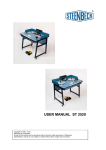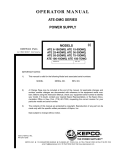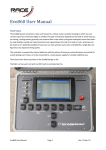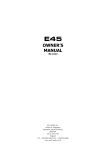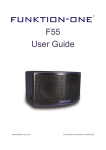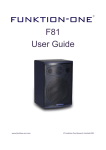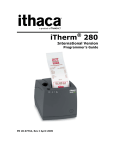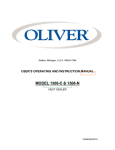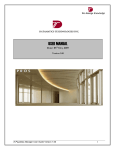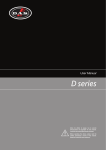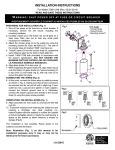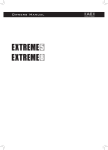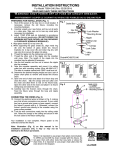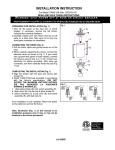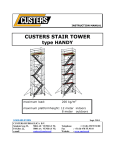Download User manual
Transcript
User manual ST 822 N8-S8 editor Copyright © 2009 – 2013. Steenbeck is a trademark. No part of this manual may be reproduced without the prior written permission of Steenbeck. Specifications, colours etc. are subject to change without notice. Images are an example. V3 -2013 ST822 0 STEENBECK ST822 USER MANUAL. Table of contents Section 0.0 1.0 2.0 3.0 3.2 3.3 3.4 4.0 5.0 6.0 7.0 8.0 Table of contents Introduction General data Technical data 3.1.1 drive system 3.1.2 film spools 3.1.3 shrunken film 3.1.4 frictions Picture Sound General data Important safety and warranty information 4.1 safety 4.2 warranty How to use the ST822: general overview 5.1 connecting to mains / basic settings / threating film 5.2 rewind / variable speed 5.3 sound 5.4 universal counter /display Connection panel (back side) Maintenance by user 7.1 tools and spare parts 7.2 introduction maintenance by user 7.3 replacing the picture lamp 7.4 adjustment of pressure arms picture 7.5 surface-coated mirrors 7.6 polygons and lenses 7.7 screens 7.8 illumination system 7.9 frictions 7.10 general maintenance 7.11 adjustment guide rings 8mm List spare parts / option 4 5 6 7 8-9 10 11 12 13 14 15 15 15 16 16 16 16 17 17 17 18 19 20 Figures 1 - 20 V3 -2013 page 1 2 2 3 21 - 29 ST822 1 1.0 INTRODUCTION TO THE ST822: The ST822 the two 8mm format editor, is a specially developed editing, viewing film table based on a solid proven concept for film archives, film restoration facilities, post production houses etc., which require extreme friendly film handling of 8mm film. The ST822 is the answer to the longstanding demand from the film archives to handle the delicate Regular (N)8mm and Super8 film format. Working with this table is comfortable. With a minimum of physical effort the film can be checked in a fast and accurate manner, the metadata is noted and the film is prepared for possible scanning. This manual shows the way to use all the possibilities of this unique film table. Read this manual carefully before starting to work. 2.0 GENERAL DATA: - - 2 plate, 2 picture film table for N8 and S8, both with COMMAG sound fast and accurate checking / viewing film separate(switchable) film systems for N8 and S8 full frame projection halogen lamp 12 Volt / 100 watt high quality projection screen digital processor counter display for actual speed of the film a safe, built in, film rewinder sound system: - COMMAG sound mono for both 8mm formats - Super 8 sound: 2 channels for main- and balance track with 2 faders - summing amp.: with treble, bass and master volume potential meter - ¼” head phone jack - two balanced XLR mono outputs - two way high quality speakers. switchable sync speeds 18 and 24 f.p.s. (frames per second) variable speed from 0 till 100 f.p.s. (approx) switch-operated variable speed with accurate images per second reading for 8mm and Super8 spools, incl. steel adapter for S8 spools ground glass, back illuminated (LED) by 7000°K light source connection with dimmer for LED or standard working lamp operating voltage selectable 100 – 240 Volt / 50 of 60Hz at 6 /10 Amp V3 -2013 ST822 2 3.0 TECHNICAL DATA: 3.1 DRIVE SYSTEM. 3.1.1 Introduction: The Steenbeck ST822 has a, proven, 1 motor drive technology. The table runs smoothly, because of the famous Steenbeck ‘speed switch’. This speed switch has fixed points for sync (synchronous 18 or 24 frames per second /f.p.s.) forward and reverse,and has adjustable notches between sync en maximum speed. (approx. 50 f.p.s.., forward and reverse selectable by user). The maximum speed can also be adjusted to 100 f.p.s. The maximum for both directions can be different. 3.1.2 Film spools: Any type of plastic 8mm spool (see fig. 8 page 23) can be used, even the 360 meter film reels. Because of the weight it’s advised not to use metal spools. Aluminium spools can be used, but use them carefully. The winding tension of the plates can be adjusted. The friction plates al made for N8 film reels. For S8 film reels use the S8 film reel adapter (see fig.8 page 23). 3.1.3 Shrunken film: The standard supplied sprocket rings are made to be used also for slightly shrunken film material. If the film is in a very bad condition it is advisable to use ONE picture pressure arm. Be carefully replaying COMMAG sound with damaged of shrunken 8mm film. 3.1.4 Frictions: The friction base plates are made for to use Regular/Standard 8mm film reels. Standard alignment of the friction is for film reels >60 meters/200 feet. Be carefull to use a smaller diameter film reels. If the tention of the friction should be readjusted: see section 7.9. V3 -2013 ST822 3 3.2 PICTURE. The rear screen projection method via an optical compensation system us done with a revolving prism (polygon). To get the maximum quality, each 8mm format has it’s own optical/polygon system. For 8mm is a 36 faced polygon installed. For S8 a 32 faced polygon. This is one of the main reason the ST822 is an expensive editor. The projection of each format is full frame and can be viewed from edge to edge. Dimensions of projection are: 230 x 160mm (approx.). The magnification of S8 image is approx. 1.500 times. The magnification of N8 image is approx. 2.400 times. The picture lamp can easily adjusted and replaced. In stand-still mode the light is automatically dimmed to prevent heat damages to the film. The easy threading of film saves time and protect the film from being damaged. (see fig. 9 -10 page 24) 3.3 SOUND. High quality sound reproduction is done by plug-in pre-amplifiers. All sound is mono. For S8 two tracks, main track (MT) and balance track (BT), both with each fader mixing into mono are available. For 8mm one track is available with fader. Summing amplifier with: -treble / bass / master volume adjust. -head phone output with 1/4” jack set to mono. (a stereo head phone can be used) 2 loudspeakers 2 way, 2 x 30 watt. Audio output: at the back of the editor are two XLR outputs (mono) available for external audio amplifier or recording. V3 -2013 ST822 4 3.4 GENERAL DATA. Power: Power consumption: 1 phase 100 – 240 Volts 50 / 60 Hz approx.. 800 W Switch on current: 10 Amps (at 230 Volt) The fuses (5 x 20mm) 100 -120 volt 220 – 240 Volt 10 amp T and 1 Amp T 6,3 amp T and 0,5 Amp T The fuses can be found on the back side of the machine. (see fig. 17 page 28) Important: all fuses in the Steenbeck ST822 are T (slow blown) and should never be replaced by F (fast blown) fuses. Sizes of a ST822 editor including monitor and speakers: width 144 cm working height 80 cm depth 110 cm total height 120 cm Weight 150 kg V3 -2013 (approx..) ST822 5 4.0 IMPORTANT SAFETY AND WARRANTY INFORMATION. 4.1 SAFETY: The installation and maintenance should always be done by Steenbeck factory engineers or an appointed /certified Steenbeck agent / dealer. Of highest importance is a well-connected and safe power ground system. This system has to be in a 100% state, because of: - the safety of the user of the ST822 - the risk of electronical malfunction both inside and outside the table. - discharge of static electricity. The ST822 should always be placed in a dry room and free from dust. The temperature should be between 15° C and 25° C (60°F 95°F) Humidity should be between 40% to 60% (approx.). A higher humidity can cause corrosion on electronic contacts. Warning: never put drinks/liquids on the Steenbeck machine. Liquid spill, when leaking into the machine, can cause great damage and can be dangerous for its user. Regularly clean the machine with the brush and the special cleaning wipes (blue is for wet use and yellow is for dry cleaning). Never open the machine. If there is any mechanical or electronically alignment needed, these should be done by a Steenbeck engineer. It’s advised to use good trained personnel to work with the Steenbeck machine. It’s very important that this personnel has read and studied the user manual. IMPORTANT: There is always a personal danger related to the revolving sprockets. Beware of this danger when having long hair, necklaces, bracelets, long sleeves etc. V3 -2013 ST822 6 4.2 WARRANTY INFORMATION: STEENBECK film machines are made with the best possible accuracy and precision. Extensive runs and tests are done on the machine prior to shipment. STEENBECK film machines are built to achieve maximum quality , reliability, and long life resulting in a minimum of maintenance. There is always the possibility that within the warranty period of 1 (one) year, after purchasing the Steenbeck, a part is not working properly. In such case, please contact the Steenbeck factory or your local Steenbeck agent/dealer at once. Defective parts will be repaired or replaced by Steenbeck. Before replacing the part, Steenbeck has the right to check the part before replacing it. No warranty in case of: - the machine is used for a different purpose than what it was made for. deliberate damage. an untrained technician has worked at the machine. defective projection or optical sound lamp, wire breakage. damage the lacquer by use, bumping or cleaning with not advised solvent. Defective parts should be send to the Steenbeck factory in Holland or the local agent/dealer at cost and risk of the owner/user of the Steenbeck machine. The costs for the repair or replacement of parts are in principle always at cost of Steenbeck. The Steenbeck factory always returns the parts free of charge. The replaced parts are always property of Steenbeck . If a Steenbeck engineer is required to take care of the warranty repairs or replacements, all travelling and accommodation costs are for the owner/user of the Steenbeck machine. V3 -2013 ST822 7 5.0 HOW TO USE THE ST822: Read this section carefully, study all the possibilities and run some tests. Make the most important actions your own. GENERAL OVERVIEW: # 1 2 3 4 5 6 7 8 9 10 11 12 (fig. 1 page 21) driving deck friction left friction right rewinder central operation panel with: ruler (centimeters and feet) ground glass (back lighted), to check film (fig. 2 page 21) speed switch central function panel (fig. 2 - #9 page 21) preamplifier sound universal counter /display (fig. 15 page 27) display speed film (frames per second: f.p.s.) (fig. 15 page 27) CENTRAL FUNCTION PANEL: (fig. 3 page 22) Switches / buttons 14 t/m 23 are the so-called sub functions. 13 14 15 16 17 18 19 20 21 22 23 24 25 V3 -2013 main power on / off switch (fig. 4 page 22) on / off switch sound (fig. 4 page 22) switch picture lamp for N8 en S8 (fig. 5 page 22) selector for N8 or S8 film size (fig. 5 page 22) selector for synchronous speed 18 of 24 f.p.s. (fig. 5 page 22) switch back light ground glass (fig. 6 page 23) variable speed on / off (fig. 6) rotary for variable speed (fig. 6) on /off switch rewinder (fig. 7 page 23) switch direction winding, left or right ( fig. 7) speed setting of the film rewinder ( fig. 7) adapter Super 8 film reel (fig. 8 page 23) film threading S8 (fig. 11 – 12 page 25) ST822 8 Operation: # 27 28 29 30 31 32 33 34 35 A 35 B 36 37 38 39 40 pressure arm picture left and right pressure arm sound sprocket, film with sound (fig. 11-12-13 page 25-26) push button (grey) to detach pressure arm cover, (lift when threating film) framing picture focus picture guide roller film (fig. 14 page 26) N8 magnetic head for main-and balance track S8 magnetic head for main- and balance track tension roller, film with sound adjusting picture lamp S8 cover picture lamp adjusting picture lamp N8 screw bearing shaft plate (see page 19) film threading N8 operation functions N8 film threading S8 (fig. 9 page 24) (fig. 10 page 24) (fig. 11 and 12 page 25) PREAMPLIFIER SOUND CASSETTE: (fig. 16 page 27) 41 42 43 44 45 46 47 fader N8 track fader S8 main track fader S8 balanced track treble control summing amp. bass control summing amp volume control summing amp head phone output CENTRAL CONNECTION- AND FUSE PANEL: (fig 17-18-19-20 page 28-29) 48 49 50 51 52 53 54 55 56 57 58 V3 -2013 connection universal counter (flat cable) connection display speed film connection dimmable LED-light 12V (working lamp) connection dimmable 220V lamp (working lamp) connection power cord panel, fuses (fig. 17 – 19 page 28 - 29) XLR output for sound L - R mono (fig. 17 – 18 page 28) connection speaker for L – R (mono) (fig. 17 - 18) dimmer for 230 Volt dimmer for 12 volt (only for LED light) place for type and serial number plate ST822 9 5.1 HOW TO USE THE ST822 (continued) Connecting to mains power: Connect the machine to the power network according to the instructions on page 5 with the supplied power cable. Make sure that this cable is well connected. Always check the Voltage and Frequency mentioned on the type and serial number plate (back side table). Of great importance is a safe power ground system. Switch the ST822 on with the main switch (fig.3 -#13 page 22), it shows a green light. Only then switch on the sub functions (from 14 onwards). Warning : before switching off the table , always switch off all the sub functions. Basic setting: Choose the film format (16) and the sync speed (17). (both on fig. 3-5 page 22 ) The winding- and unwinding frictions can handle N8 and S8 spools (fig. 8 page ). For S8 there is a metal adapter fig. 8 - #24 page 23) . For winding it’s advised to use a plastic S8 spool. Old steel and / or aluminium spools can be bent or damaged. When using these spools the friction plate and its guiding pins can get damaged. Threating film: Threat S8 film according to fig.11 en 12 (page 25). Caution: in order to prevent unnecessary wear, when threating film without sound, never use the magnetic head (fig.12 - #35 page 25) and sprocket (fig. 13 - #29 page 26), and switch off the sound (fig. 4 - #14 page 22). It’s advised to use the supplied spool or an equivalent. When the film has sound, threat the film with sprocket (29) in a way the tension roller can move a little bit, because when there is too much tension on the film it can damage the perforation. Use the speed switch (fig. 1 - #8 page 21) to view the film. While winding or rewinding from 0 to sync speed and sync, the speed is continuously variable. This makes it possible to view the film frame by frame. When the framing is not correct it can be adjusted (fig. 12 - #32 page 25). Focus picture is adjustable (fig. 12 - #33 page 25). Threating N8 film is like S8 (fig. 9 en 10 page 24). Fig. 13 (page 26) shows the way to threat film without sound. V3 -2013 ST822 10 5.2 HOW TO USE THE ST822 (continued) Attention: the magnification of the N8 and S8 image on the ST822 is significant. The magnification of the S8 image is ~1.500x The magnification of the N8 image is even ~2.400 x. Every detail and any problem on the image will be shown directly. The image part of the ST822 has small margins, therefore the image will move a little. Steenbeck has chosen for a so-called “full frame” projection enabling to see all the frame lines of the image. Because of this “full frame” the slightest move of the frame can be noticed. Rewind: Don’t rewind the film as it is threat for viewing, because of the sprockets, older films with bad splices and perforation can get damaged. It’s advised to rewind the film always with the built in film rewinder (fig.1.- #4 page 21). This rewinder can wind forward and backward and the speed can be adjusted This can be useful when it’s required to check or clean the film by hand. Caution: be careful that the motor of the rewinder doesn’t get overloaded. Threat the film, for winding, as shown in fig.14 (page 26) It is important to threat the film over the two guide rollers fig. 14 - #34 page 26). Fig. 7 (page 23) shows the control panel for the motor rewinder. Switch (21) activates the rewinder. (fig. 6 – page 23) Switch (22) adjusts the winding direction. “ Button (23) adjusts the speed. “ The motor of the rewinder doesn’t stop automatically. Variable speed: The synchronous speeds are 18 and 24 frames per second. The 18 f.p.s. speed is for S8. The 24 f.p.s. speed is for both S8 and for N8. For a different speed, like16 f.p.s. as for N8, the variable speed adjuster can be interesting. The exact speed can be read on the display (fig. 15 - # 12 page 27) and fig.1- #12 page 21). V3 -2013 ST822 11 5.3 HOW TO USE THE ST822 (continued) Sound: With the ST822 N8 / S8 film can be viewed with sound (stripe), film and sound synchronously. The image-sound distance is normalized. The pre-amplifier cassette (fig. 16 page 27) is for the pre-amp: - MT8 main track S8 (42) - BT8 balance track S8 (43) - N8 main track N8 (41) With S8 it’s possible to play both the main track and the balance track. Each track has its own fader When there is a S8 film with stereo or duo-play sound, a “mix” of the two tracks can be made by using the faders. Adjustment of the volume with button (46). Adjustment of the sound by treble (44) and bass (45) Plug in a headphone with a ‘1/4”jack’ (47). When a headphone is used, the speakers are off. When sound of the headphone is too soft, it’s caused by the impedance of the headphone. At the back of the machine the connection- and fuses panel can be found. (fig. 17 – #18 – 19 page 28-29). as well as the XLR output (mono) (fig.18 - #54 page 28) With this option external sound can be recorded or played. The sound of this output is only controlled by the fader of this track. The connection of the speakers (fig.17-18 - #55 page 28) are of a special kind (Neutrik) and can be released by a short turn. Caution: When the level of the headphone is to low, it is caused by the impedance of the headphone. V3 -2013 ST822 12 5.4 Universal counter: This counter is placed below the monitor fig. 1 - #11 and fig. 15. This counter measures film length, elapsed time and frames in 2 counters (I – 0) (60). The button 8S (61) is always activated and shows a red LED. . When the synchronous speed changes the counter automatically adjusts. At 24 f.p.s..: green LED (62). At 18 f.p.s .: no LED. Button ‘C ‘ (63) stands for ‘clear’, to reset the counter. Button ‘hold’ (64) stops the counter while the table is running, in case a certain length needs to be measured. This button should be pressed to continue as long as necessary . The count always runs during the hold . During the counting, one can always switch between time and length without changing the count. Display (12): shows always de speed of the film in frames per second (f.p.s.) . 60 63 V3 -2013 62 61 12 64 ST822 13 6.0 CONNECTION PANEL (at the back of ST822) (fig. 17-18-19 page 28-29) At the back of the machine is a connection panel and 3 plugs. Fuse panel: (fig. 19 page 29) It contains: 3 glass fuses 5 x 20mm: 2 x 6,3 Amp. T / 220 – 240 V. or 2 x 10 Amp. T / 100 – 110 V. 1 x 0,5 Amp. T / 220 – 240 V. or 1 x 1,0 Amp. T / 100 – 110 V. The fuses are located in a holder with bayonet. If a fuse has blown, the pilot light next to it will burn. The ST822 doesn’t use the connection ‘interlock’. Sound and light panel: (fig. 18 page 28) speakers: The two top connections are for the speakers. (55), with a special plug (Neutrik NL2FC). This plug can be released by a short turn. Line out: With this XLR outputs (mono) (54) one can play or record sound for example by using an amplifier. The XLR is balanced. Connection: pin 1 = ground / pin 2 = + (phase) / pin 3 = - (return). Work light: (fig. 18 page 28) There a 2 connections: 4 pin connection for 230V light max. 60 Watt. (51) 3 pin connection for 12V LED max. 1 Amp. (50) The connection is as follows: 230 Volt: pin 1 = phase + / pin 2 = phase - / pin 3 = ground / 12V LED: pin 1 = + / pin 2 = / pin 3 = N.C.* pin 4 = NC* (N.C.* = Not Connected ) At the left side of the ST822, just behind the left front leg (fig.20 page 29) two dimmers can be found. Dimmer (56) for 230 Volt. Dimmer (57) for 12 Volt LED. Caution: be careful connecting the work light. V3 -2013 ST822 14 7.0 MAINTENANCE BY USER 7.1 Tools and spare parts: (delivered with ST822) part number: Tools: 1 x wrench M2,5 to adjust frictions 1 x hexagon M5 to adjust picture lamp Cleaning brush Cleaning cloths ( blue and yellow) 9962.0088.00 9962.0089.00 N000.0473.00 N000.0521.00 Spare parts: 2 x picture lamp 12V- 100W 4 x fuse 6,3 Amp. T 2 x fuse 0,5 Amp. T 9956.1066.00 9956.0232.00 9956.0224.00 Various: Power cable. S8 spool 240 meter S8 adaptor, 3 pcs. Dust cover Base plate spool B000.0247.00 N000.0529.00 N000.0055.00 9962.1083.00 N000.0494.00 Connector 230 volt work light Connector 12 Volt LED work light N000.0419.00 N000.0420.00 7.2 Introduction maintenance by user: The ST822 doesn’t need much maintenance. It depends on by whom, how and under what circumstances the table is used. It’s advised to clean the table every time it has been used with the supplied brush. Clean the top of the table with the supplied cloth; Start cleaning with a moist microfiber cloth (Blue) and dry it with the (Yellow ) dry cloth. Caution: technical maintenance: When the ST822 is regularly used the maintenance needs to be done at least once a year by the dealer or Steenbeck factory engineer. In this way the table will stay in a good condition. To facilitate the opereration the following instructions should be strictly adhered to. (page 15 - 19 ) = only done by skilled staff Before opening the machine be sure it is disconnected from the mains. Only service engineers are authorized to do adjustment and technical maintenance. The machine should only be operated with the side and front panels closed. V3 -2013 ST822 15 7.3 Replacing the picture lamp. Lift cover plate (fig. 11- #38 page 25) beside the left pressure arm (fig. 12 - #27 page 25). Tilt back cap above picture lamp. With the aid of the tool supplied the defective lamp is lifted out, and the new one is carefully and gently pressed into the lamp socket. ALWAYS readjust the newly inserted picture lamp. NEVER touch the bulb with your fingers or clean it with a chemical alcohol. 7.4 Adjustment of pressure arms picture. Feed two films strips through the sprocket and counterpress arms. Loosen screws at the bearing shaft plate (#40 – page 19) and change pressure of the arm so that both guide rollers are under the same pressure. Now tighten screws. Loosen fixing screws of locking pin. Turn it, so that there is no play between film and guide roller. Tighten fixing screws. As pressure arms are adjusted for two thicknesses of film by manufacturer, readjustment is only necessary after dismantling of the bearing shaft or the locking pin. Maintenance of optical parts. 7.5 Surface-coated mirrors. Cleaning may only be done with a soft lens brush or lens cloth. If the mirror is very dirty, detach it and clean carefully with clear water and cotton wool. To avoid water stains the final touch is made with dry cotton wool. 7.6 Polygons and lenses. If the polygon is just a slightly soiled, open the pressure arms from the front and clean with soft leather, cotton or special optician’s tissue. For more thorough cleaning the support of the upper film guide support can be removed (page 19) For this purpose remove at first the cap from the objective and prism (page 19), than loosen the 2 screws of the support and the upper film guide support can be taken off. One has free access to the polygon now, When remounting the support be sure the surface of the base is clean, otherwise the upper film guide and sprocket ring do not line up. The objective and prism can only be cleaned with the housing removed. This should done by an Steenbeck engineer only because of optical alignment of the projected image. V3 -2013 ST822 16 7.7 Screen. The surface of the synthetic material is sensitive and can easily be scratched. It is advisable to clean the screen regularly with a soft close. If more cleaning becomes necessary, unscrew the screen from the screen holder (11 – fig. 1) and clean it with water. Caution: -do not used any chemicals. -pull the counter flat cable plug before removing the screen (holder). 7.8 illumination system. The upper prism and its lenses (condenser page 19) can be unscrewed and cleaned in the same manner as the revolving prism (polygon). See 7.5 – 7.6 When the prism / condenser has been removed the cold light mirror is visible. This cold light mirror below the prism / condensor is held in place by a spring. To remove the mirror, the table has to be opened and is reachable from the inside. Pull the spring back and clean the mirror like a front surface coated mirror. 7.9 Frictions. (take up and supply units) Drive belts: Frictions are operated by a motor via multiple V-belts. It may become necessary to adjust the belt tension after a certain operating time. To achieve this, open frame on both sides, loosen the corresponding tension roller arms with a wrench M5 (8mm) and adjust the belt tension Frictions: The wind pull of the centre cores can be adjusted with the little tension bolt inside the round mandrel of each friction. For readjustment take off the film core. The tension bolt can be turned then by an allen key (hexagon) 2.5mm Steenbeck part number 9962.0088.00. When turning anticlockwise the wind pull will be more firm. When turning clockwise the wind pull becomes looser. The wind pull should be checked by means of rolling film on the reel and check If the 8mm film is not to tight or to loosen on the film reel. Caution: be always very careful adjusting the friction, better NOT to tight otherwise damages are done easily to the 8mm film. V3 -2013 ST822 17 7.10 General maintenance. Remove dust, scrapping and film remainders from the machine DAILY. After every approx. 100 hours of operation: Clean all guide rollers, pressure arms/rollers and sprockets from possible remainders of film and tape. For cleaning the teeth of sprockets use a wooden stick. Never use steel tools. After every approx. 500 hours of operation: Take off all rollers, clean rollers, shaft of rollers and axles with cleaning solvent. Grease slightly the axles and shaft with a highly fluid oil. After every approx. 1000 hours of operation: Change motor oil in gear box as follows: -open the middle panel of the chassis. (near your knees when sitting behind the table) -look for the drain screw at the bottom and the filling screw at the top of the gear box. Loosen both screws. Empty the old oil into a container. After tightening of the drain screw refill the box with new oil ATF, approx.. 22cc. An elapsed time counter is available as an option. (Z50) V3 -2013 ST822 18 7.11 Adjustment guide rings 8mm. cap guide support screws 40 E 27 condensor system Film can differ in width. The width “A” is normally set to 8mm – 0,2mm. If the film is bending on the film gate the width must be adjusted. To do this the cover “C” must be removed with a blade or anything similar. The screw “B” should be turned anticlockwise with a two pin key. If the film is loose on the gate (horizontal picture jitter), the screw “B” should be turned clockwise. Caution: With old film be careful to make alignments. Extra attention should be given when shrunken film is in the gate. Try first to use one of the two picture pressure arm (27). Make a careful test. V3 -2013 ST822 19 8.0 SPARE PARTS # Adapter S8 24 Magnetic Head N8 Magnetic head S8 Fig. page PART NUMBER 8 23 N000.0055.00 35A 10 35B 12 24 25 N000.0082.00 N000.0083.00 pre-amplifier 16mm magnetic sound master amplifier stereo 43 43 16 16 27 27 3928.0012.04 3928.0022.15 Roller guide S8/N8 Roller pressure N8 Roller pressure S8 34 28 12 12 25 25 N000.0061.00 N000.0059.00 N000.0060.00 Spool 240 mtr. Switch power on/of Switch format Switch speed Switch varia speed Switch ground glass Switch rewinder on/of Switch rewinder direction 13 16 17 19 18 21 22 3 22 22 22 22 22 22 22 N000.0529.00 N000.0190.00 N000.0214.00 N000.0214.00 N000.0193.00 N000.0191.00 N000.0191.00 N000.0192.00 Switch sound 13 3 22 N000.0191.00 20/23 3 22 N000.0194.00 22 22 N000.0196.00 9950.1395.00 Knob potentiometer, speed rewinder. and variable speed Potentiometer varia speed Potentiometer speed rewinder 23 OPTION: ST58 Table working lamp. V3 -2013 ST822 20 4 2 1 11 12 3 Fig. 1 5 6 7 9 8 10 Fig. 2 9 V3 -2013 7 ST822 21 23 22 21 13 14 15 16 17 19 20 18 Fig. 3 13 14 Fig. 4 15 16 17 Fig. 5 V3 -2013 ST822 22 19 20 21 Fig 6 23 22 21 Fig. 7 24 Fig. 8 V3 -2013 ST822 23 Fig. 9 36 35A Fig. 10 37 39 V3 -2013 ST822 24 38 29 Fig. 11 34 39 27 32 37 33 27 Fig. 12 35 36 30 34 V3 -2013 31 30 29 ST822 28 25 Fig. 13 29 Fig. 14 4 V3 -2013 34 ST822 26 11 12 Fig. 15 Fig. 16 44 45 46 47 41 V3 -2013 42 43 ST822 27 48 49 58 55 54 51 Fig. 17 not in use 52 53 Fig. 18 55 54 50 V3 -2013 ST822 51 28 Fig. 19 not in use 56 ( 230V) Fig. 20 left hand side frame 57 ( 12 V) STEENBECK B.V. (Ltd.) Keizersveld 31, 5803 AM VENRAY. The Netherlands Tel: +31 (0)478 63 03 00 Fax: +31 (0)478 69 00 07 [email protected] www.steenbeck.com V3 -2013 ST822 29
































